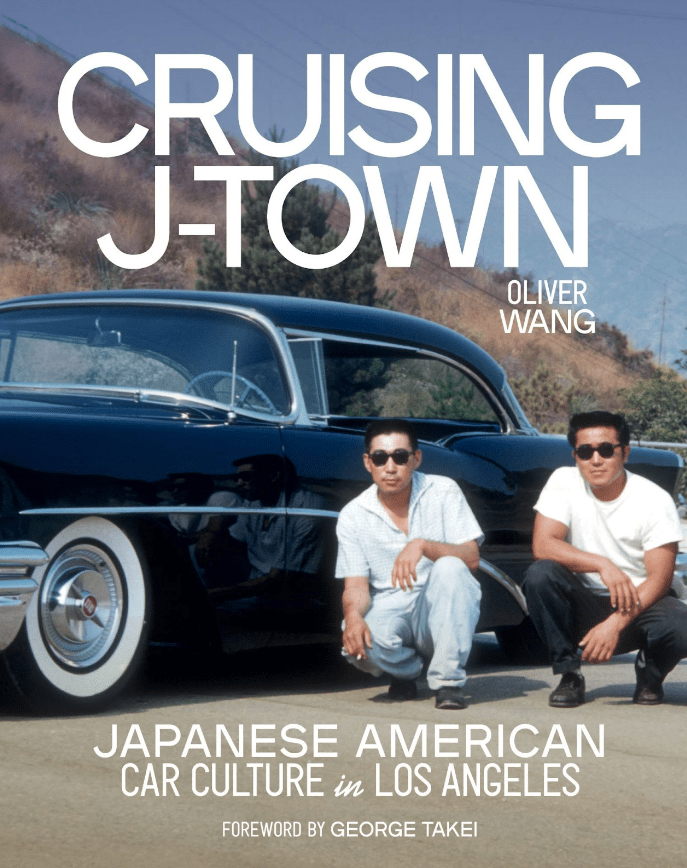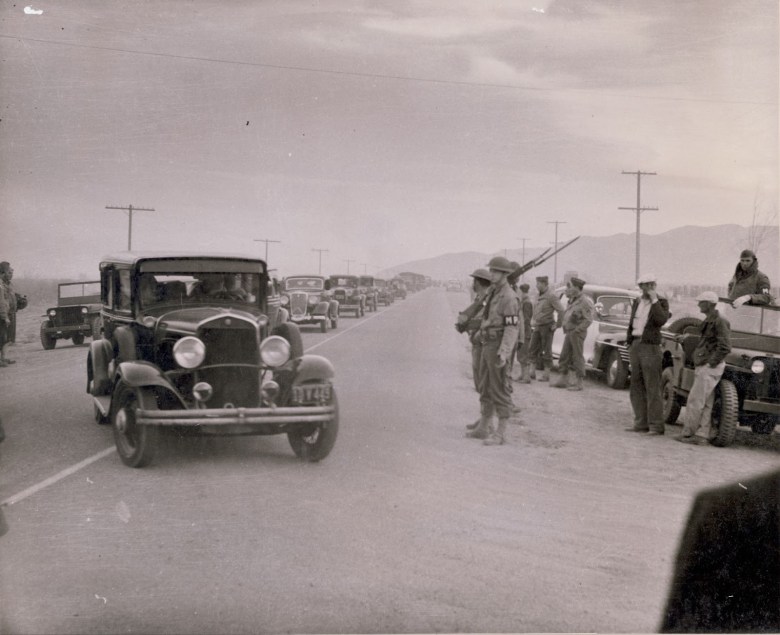 Photo by Jack Iwata, gift of Jack and Peggy Iwata, Japanese American National Museum
Photo by Jack Iwata, gift of Jack and Peggy Iwata, Japanese American National Museum
Incarcerees belonging to the March 23, 1942 caravan from Pasadena, arriving to Manzanar.
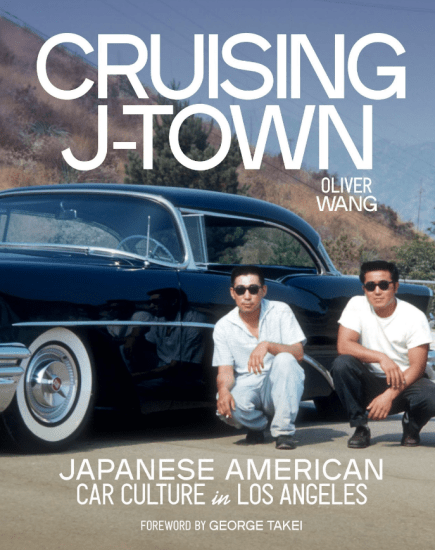
Angel City Press at the Los Angeles Public Library announces the publication of “Cruising J-Town,” a visual history of Japanese American car culture in Los Angeles, from gardeners’ trucks and family sedans to hot rods and race cars.
“Cruising J-Town” by Oliver Wang, with a foreword by George Takei, explores how generations of Japanese Americans in Southern California shaped, and were shaped by, local automobile cultures and industries. From desert lake beds to concrete speedways, gas stations to design centers, souped-up import tuners to humble gardening trucks, automobiles impacted Japanese Americans in profound ways.
Along the way, cars and trucks became literal and figurative vehicles for Japanese American self-expression, social mobility, community identity, and much more. “Cruising J-Town” is driven to explore how these diverse relationships between people and the world of cars have steered the Nikkei community’s American stories across the generations.
The book is a companion publication to a new exhibition from the Japanese American National Museum, “Cruising J-Town: Behind the Wheel of the Nikkei Community,” which also chronicles how Japanese Americans have played vital roles in countless car scenes across Los Angeles.
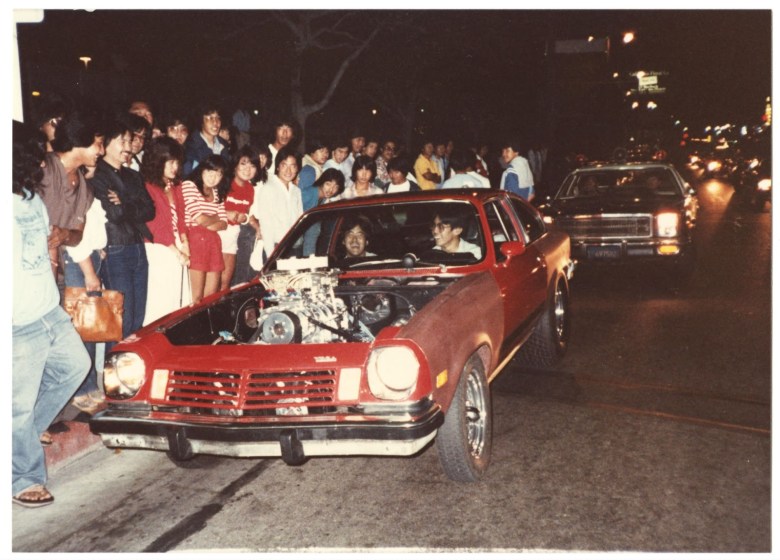 Courtesy of Tod Kaneko
Courtesy of Tod Kaneko
Street racers Tod Kaneko and David Eguchi, inside of Glen Kuwata’s Chevrolet Vega, during a Nisei Week cruise, Little Tokyo, 1982.
The book traces the history of the Japanese American community alongside the development of the car, from the earliest days of the automobile. Japanese American farmers became some of Los Angeles’ earliest drivers as they trucked their crops from field to market. These communities embraced the automobile as a new horizon for their prospects in the U.S.
Car clubs, such as the Japanese Auto Club of Southern California (JACSC), were created to connect Nikkei car owners and educate them about basic road safety and etiquette. With the increasing popularity of cars came the need to maintain them, so mechanics and gas stations in J-Town (also known as Little Tokyo) became community centers where families and individuals came together to maintain both their cars and their relationships with the community.
During World War II, many Japanese Americans drove themselves to incarceration camps, and their impounded cars became literal and visible reminders of the freedoms they had left behind. After the war, Japanese Americans embraced the mid-century car culture that swept across Southern California, becoming devoted hot-rodders, drag racers, and car customizers.
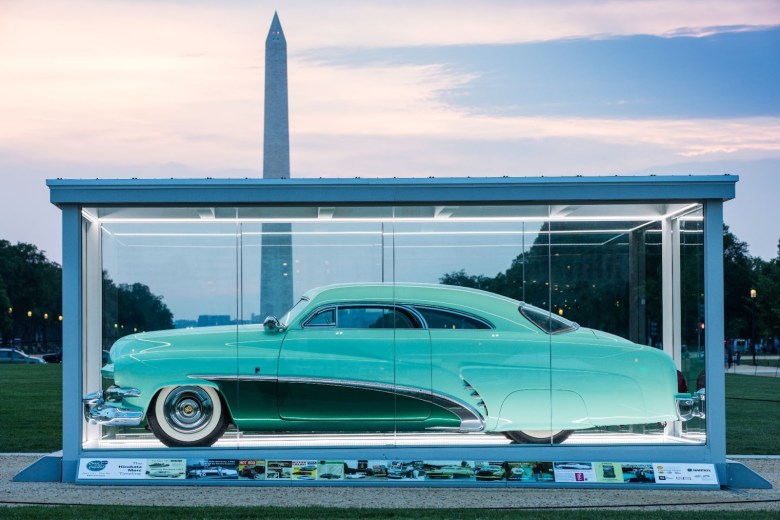 Courtesy of Hagerty Drivers Foundation
Courtesy of Hagerty Drivers Foundation
Bob Hirohata’s 1951 Mercury Coupe, aka the Hirohata Merc, on the National Mall, Washington D.C., 2017. The car was displayed after being added to the National Historical Vehicle Registry.
“Cruising” became a popular pastime for JA teenagers, culminating in the Nisei Week Cruise in Little Tokyo, which was undoubtedly the coolest place to show off a custom car. In fact, one of the most famous custom cars in America, the Hirohata Merc, was modified in East L.A. for a Japanese American, Bob Hirohata.
As import car scenes of the 1980s and 1990s took over the landscape, Japanese Americans were among the first to embrace the new Toyotas and Nissans coming across the ocean and popularized the art and sport of drifting, which originated in Japan.
But “Cruising J-Town” is more than a history of a machine, or even an art form. The book is filled with vintage and contemporary photographs, drawings, and ephemera that tell the story of a community in a state of constant transition and growth, using cars as a literal vehicle for creativity, dreams, and the enduring quest for freedom. It’s a story of generations coming together to pass down knowledge and their love of cars.
“An astonishing work born of love and deep curiosity, filled with a remarkable trove of never before published photographs, ‘Cruising J-Town’ tells the story of the Japanese in America in search of work or adventure, new ways of fitting in or standing out, blissful reprieves while crawling through traffic, the D.I.Y. pride of making something your own.” — Hua Hsu, author of “Stay True”
“What a gift to L.A. history. Bursting with original research, eye-popping archives, and skilled storytelling, ‘Cruising J-Town’ meticulously — and joyfully — peels back over a century’s worth of Japanese American culture and community in Los Angeles. Wang has delivered a game-changing book.” — Josh Kun, author of “The Autograph Book of L.A.”
Oliver Wang is a professor of sociology at CSU-Long Beach and the author of “Legions of Boom: Filipino American Mobile DJ Crews of the San Francisco Bay Area” (Duke University Press, 2015). He is a regular writer on music, arts and culture for outlets including NPR’s “All Things Considered,” The Los Angeles Review of Books, Los Angeles Times, and KCET’s “Artbound.”
He has co-hosted the podcasts “Pop Rocket” and “Heat Rocks” and is currently developing a new podcast on the songs of Asian America. He currently lives in the San Gabriel Valley.
The JANM exhibition, curated by Wang, is on view through Nov. 12. at the Peter and Merle Mullin Gallery, ArtCenter College of Design, 1111 S. Arroyo Parkway, Pasadena For more information, visit www.janm.org/exhibits/cruising-j-town.
For more information on the book, go to www.angelcitypress.com.
Articles for you
